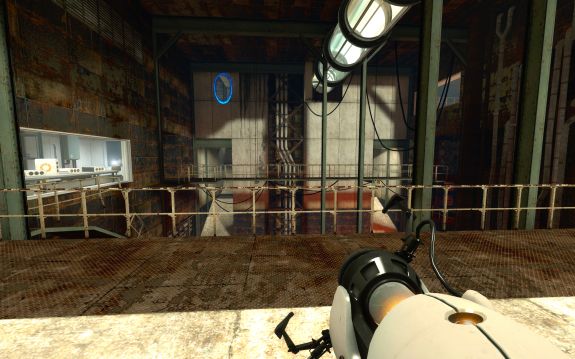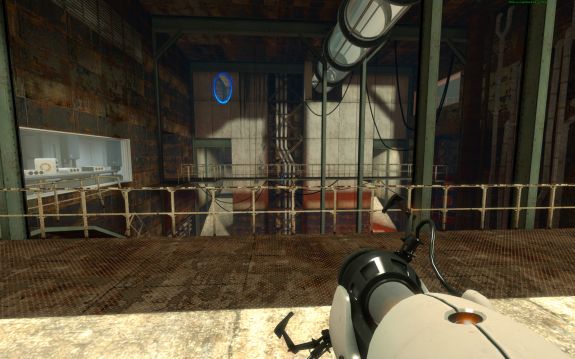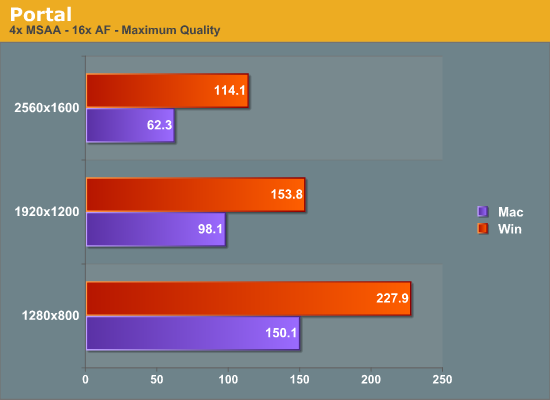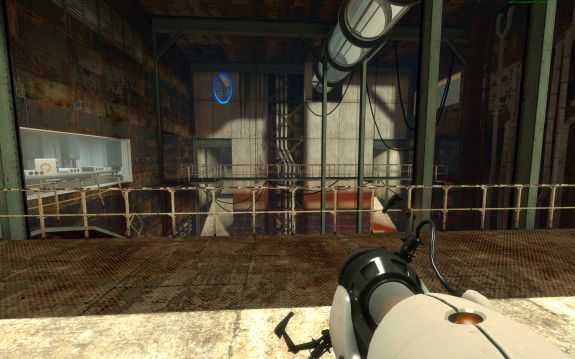Update 5/15/2010: Valve released a new patch for Portal on the 13th which resolved the blurriness issue. Please see our update below for for the full details.
It’s been a while since anyone treated Mac OS X as a first-tier gaming platform, so when Valve announced that they would be bringing their Steam service and the Source engine to the Mac, it was big news. After a roughly 2 month beta period for the Mac versions of Steam and the Source engine, yesterday Valve finally released the first wave of their Mac gaming efforts.
As it stands Valve is taking a gradual approach to rolling out their back catalog to the platform. Even though Steam is out and the Source engine has been ported, this week has seen the release of only 1 Source game for the Mac: 2007’s critically acclaimed Portal.
While it’s not the most graphically intensive Source game these days (that title belonging to Left 4 Dead), at this point it’s as good as anything else for looking at the performance of the Source engine under Mac OS X, particularly considering how long it’s been since a game’s original developer did the Mac port. So with that in mind, we went ahead and took a quick look at Portal’s performance under Mac OS X.
As is the case with all of the games on the Source engine, they’re designed to scale up and down fairly well. With modern hardware though, we’re hard-pressed to keep older Source games from achieving runaway frame rates. So Portal performance is somewhat arbitrary – most Macs with a discrete GPU should be able to handle it to an acceptable degree.
The Test
For our test we loaded up our GPU test rig with Mac OS X 10.6.3 in a Hackintosh configuration. As Mac OS X does not currently support either the GeForce GTX 400 series or the Radeon HD 5000 series, we had to step back a bit with our video card choice, settling for a GeForce GTX 285. And while the use of a Hackintosh does technically invalidate our results since it’s not a real Macintosh, based on our experiments we believe that our results don’t suffer in any way for using a Hackintosh, and as such we believe the results to be experimentally valid. But of course, your mileage may vary.
| CPU: | Intel Core i7-920 @ 3.33GHz |
| Motherboard: | Intel DX58SO (Intel X58) |
| Chipset Drivers: | Intel 9.1.1.1015 (Intel) |
| Hard Disk: | OCZ Summit (120GB) |
| Memory: | Patriot Viper DDR3-1333 3 x 2GB (7-7-7-20) |
| Video Cards: | NVIDIA GeForce GTX 285 |
| Video Drivers: | NVIDIA ForceWare 197.13 |
| OS: |
Windows 7 Ultimate 64-bit Mac OS X 10.6.3 "Snow Leopard" |
Image Quality
We’ll start quickly with a look at image quality. Valve is traditionally a staunch Microsoft ally, having built up their services and engines around Windows and DirectX. For the Mac OS X port of Source, Valve had to replace the DirectX backend of Source with Mac-appropriate components, the key of which is OpenGL. Such a change can impact image quality depending on how it’s done.

Portal - Windows. Click to enlarge

Portal - Mac OS X. Click to enlarge.
We have a gallery of screenshots, but for our analysis we’ll stick with comparing in a single set. Going with 2560x1600 with the game at its highest settings and 4xAA/16xAF, to our surprise the images are distinctly different when directly compared. The Mac screenshot is noticeably foggier than the Windows image, and textures appear to be less sharp. It’s not a night & day difference, but the Windows screenshot is distinctly clearer than the Mac screenshot. Without a Windows reference image it would be harder to tell that the Mac screenshot differs this much, but we believe that the difference is great enough that anyone with an eye for details that has ever played Portal on Windows would notice the foggier/blurrier IQ on the Mac.
Now some of this can be explained away due to gamma, since Mac OS X and Windows have different default gamma levels, but gamma could never explain the entire difference. There’s clearly a difference in IQ between the Windows and Mac OS X versions of Portal, and it’s not in the Mac’s favor. It’s by no means bad, but as one person put this when being shown these screenshots “It’s like looking at a magazine scan” when looking at the Mac.
Performance
The other half of our quick look is at performance. The Macintosh platform is renowned for being a graphical powerhouse, but this refers to professional/prosumer photography and the like. For gaming, Apple has been slow to include support for new hardware and new driver features (they are just now OpenGL 3.0 compliant) and overall their drivers are more conservative when it comes to performance. Portal is going to be slower, the question is by how much.

We went ahead and ran a timedemo from test chamber 18 and beyond on both the Mac OS X and Windows versions of Portal. We kept the settings cranked up at all times, but varied the resolution between 1280x800 and 2560x1600 to look at different GPU loads. At the worst-case of 2560, the Mac version of Portal runs at only 54% of the speed of the Windows version. That moves to 63% at 1920x1200, and 66% at 1280x800.
Portal – like all Source engine games – is CPU limited when given a powerful enough GPU, and even with just a GTX 285 we can approach that under Windows. Under Mac OS X however, we look to be GPU limited at all times. The framerate never suffers as we’re always averaging more than 60fps, but we can easily turn off MSAA and AF to improve performance if we needed to.
Closing Thoughts
For Source engine enthusaists hoping to see the Mac OS X port of the Source engine meet the high standards of the Windows version, Portal presents a mixed bag. In our limited testing the Mac version of Portal doesn’t significantly suffer for being a port, but at the same time it can’t quite match the image quality of the Windows version. Feature-for-feature there is parity, but the Mac version just isn’t as sharp as the Windows version.
Performance isn’t any better. Portal is an easy game to run and so we’re largely being academic here, but the “tax” for Mac OS X is roughly a generation in hardware performance. For the performance we’re seeing on a GTX 285 under Mac OS X the results are similar to what we’d see under Windows with something like a 9800GTX. Given that at the high-end the Mac platform is also a generation behind in hardware, and you’re looking at 2008 performance for Portal even with the best hardware you can get today for a Mac.
Ultimately having the Source engine ported to Mac OS X is going to remove the technical need to use Bootcamp to run Windows for games, but based on Portal it doesn’t remove the need to boot Windows for performance reasons. For long-time Mac users none of this should be surprising, but it means that we shouldn’t expect the Mac OS X version of the Source engine to be revolutionary.
Update: 5/15/2010
On Thursday after we published our article Valve pushed out an update for Portal that focused on fixes for the Mac version. The big fix was the following:
Fixed screen "fuzziness" caused by color correction operation
This fixed the blurriness issue we saw with the initial version of Portal. Texture and geometry quality is now as sharp as it is under Windows. Performance remains unchanged, while there is still an image quality difference between the two due to lighting differences and a general degree of fogginess that still appears on the Mac OS X version.























178 Comments
View All Comments
Scali - Friday, May 14, 2010 - link
Possible, but not likely.Firstly, there aren't any thermal issues, since they used the same PC in Windows and OS X.
If it had thermal issues, it couldn't have performed flawlessly in Windows either (the posted figures are perfectly normal for Windows).
Secondly, I posted some benchmarks of a Hackintosh vs some real Macs elsewhere in this thread, and they showed nothing unusual. The Hackintosh performed just fine, and actually outperformed the real Macs in some areas (because better parts were used).
So I see no reason to doubt these figures.
ochentay4 - Thursday, May 13, 2010 - link
I think that a Hackintosh is the LAST thing I would use as a Test Base. Unsupported hacks, drivers and whoknowswhat software on a Hackintosh WILL NOT be in the same league as a real Mac. Period. This test should include ONLY Macs, and Hardware certified by Apple for useon Macs. This test should haveAT LEAST:
-A MacBook
-A MacBook Pro with a good video card
-An iMac
-An iMac with a good video card.
-And a Mac Mini just lo laugh.
Anything below this is unimportant.
EarthwormJim - Thursday, May 13, 2010 - link
Why wasn't this run on an actual Mac, with the actual hardware that ships with a Mac?It would be nice to see if the roughly 50% performance drop is across all hardware levels, including integrated graphics on Macbooks.
t0njohn - Thursday, May 13, 2010 - link
I would love to see more thorough benchmarks across the range of supported hardware and software (OSX 10.5.8 vs 10.6.3 on the same hw would be interesting).Ryan Smith - Thursday, May 13, 2010 - link
I don't have a Mac suitable to run Portal (it's a G4) and otherwise it's Anand that's our resident Mac-head. If he was here, then yeah, we likely would have done some testing on a variety of real Macs. In the mean time though, we still have an opportunity to look at the performance of the Source engine under Mac OS X.EarthwormJim - Thursday, May 13, 2010 - link
Ah ok you didn't have a Mac on hand.I have no problem with the hackintosh approach, just GTX285's are rare in Macs.
Do you have some low level GPUs that are comparable to the ones in Macbooks or iMacs?
Ryan Smith - Friday, May 14, 2010 - link
Unfortunately not. Hackintosh GPU compatibility is fairly limited and it won't take most of my low-end GPUs.takumsawsherman - Thursday, May 13, 2010 - link
One piece of analysis that I noticed was lacking is that this software for the Mac is new and presumably not as optimized as the version for the PC. Of course, hardware drivers are going to have a significant effect, but I think that putting it all on the drivers/OS is avoiding the elephant in the room.PartEleven - Thursday, May 13, 2010 - link
I'm getting increasing annoyed by comments about how horrible articles are because they don't provide "real life" comparisons using the exact configuration they have at home. That's completely missing the point of this article. From what I can see, this article is trying to answer the question: Does Portal perform the same on a Mac versus the PC? Using such high end hardware allows a performance comparison across multiple resolution/quality settings, more so than if they used "realistic" mid-range hardware. It also gives you an idea of what the absolute maximum performance you'll see out of the Mac, and revealed that the Mac is still GPU bound at extreme settings even with the best hardware. This article is NOT meant to tell you if your Macbook can run Portal, and what kind of fps you should expect.And what if they did use a more "realistic" test Mac? How much more would you learn from it? Chances are they won't be using your exact hardware configuration, so you will still be guessing at what kind of performance you'll be seeing. And why not just try Portal and benchmark it yourself on your Mac? It's being offered FREE on Steam, and I'm willing to bet most people interested in playing it on Mac ALREADY HAS A MAC. It'snot like you this article will help you decide which Mac to get.
beelsebob - Thursday, May 13, 2010 - link
The point is that the article *doesn't* provide any kind of guide for how a high end system compares. Mac OS does not support the graphics card used *at all*, it just happens that the driver for an nVidia card in *a different generation* manages to run it... ish.Given that much of the results from the article are based on the quality of the drivers available on Mac OS, and no decent driver has ever been provided for this card, it's flawed, badly.